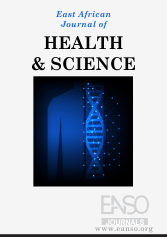Evaluating the Antimicrobial Activity of Crude Extracts from Leaves, Flowers and Roots of Iris versicolor and Nerium oleander Plants Against Escherichia coli and Staphylococcus aureus
Abstract
Bacterial infections are prevalent in most parts of Kenya and cause diseases like pneumonia, typhoid, cholera, and meningitis. This has contributed to unsustainable socio-economic development following the emergence of antimicrobial-resistant strains of bacteria and, hence, the need for alternative strategies that are effective against bacteria and environmentally safe. This study evaluated the antimicrobial activity of crude extracts from leaves, flowers and roots of Iris versicolor and Nerium oleander plants against Escherichia coli and Staphylococcus aureus. The plant parts were macerated and extracted to obtain phytochemicals that were then identified under different classes of compounds by treating them with varying reagents following standard laboratory procedures. To assess antimicrobial activity, discs were infused with an antimicrobial compound derived from the leaf, flower, and root extracts of N. oleander and I. versicolor at a concentration of 1000 µg/ml. Bacterial isolates (inoculum) were then introduced into plates containing Mueller-Hinton agar media. Infused discs were dispensed aseptically on the plates. The discs were pressed to ensure contact between the agar and the disc and incubated at 37 °C for 24 hrs. The Kirby-Bauer method was used to assess the antibacterial efficacy of the plant extracts against the bacterial strains Staphylococcus aureus and Escherichia coli. The crude plant extracts showed a greater zone of inhibition ranging from 2.5 mm to 3.2 mm in diameter, irrespective of the plant part and the test micro-organism. The methanolic crude extract of N. oleander leaves showed a greater zone of inhibition against Staphylococcus aureus at 3.1 mm and 2.9 mm against E. coli. The zone inhibited by the crude extract on S. aureus showed no growth of the micro-organisms; this was observed on all the crude extracts, irrespective of the extracting solvent, on both E. coli and S. aureus. The methanolic crude extract of N. oleander flowers showed a greater zone of inhibition against S. aureus at 2.9 mm. The hexane crude extract of I. versicolor leaves showed the least zone of inhibition against E. coli at 2.2 mm in diameter. This showed that the plant crude extracts exhibited much higher activity against S. aureus, followed by E. coli
Downloads
References
Abdallah, E. M., Alhatlani, B. Y., de Paula Menezes, R. & Martins, C. H. G. (2023). Back to Nature: Medicinal plants as promising sources for antibacterial drugs in the post-antibiotic era. Plants, 12(17), 3077
Atanasov, A. G., Waltenberger, B., Pferschy-Wenzig, E.-M., Linder, T., Wawrosch, C., Uhrin, P., Temml, V., Wang, L., Schwaiger, S., & Heiss, E. H. (2015). Discovery and resupply of pharmacologically active plant-derived natural products: A review. Biotechnology Advances, 33(8), 1582–1614.
Erdman Jr, J. W. (2023). Health and nutrition beyond essential nutrients: The evolution of the bioactive concept for human health. Molecular Aspects of Medicine, 89, 101116
Harikrishnan, R., & Balasundaram, C. (2020). Potential of Herbal Extracts and Bioactive Compounds for Human Healthcare. In The Role of Phytoconstituents in Health Care (pp. 3–158). Apple Academic Press
Jaegerova, T., Zlechovcova, M., Benes, F., Kronusova, O., Kastanek, P., & Hajslova, J. (2024). Investigation of Iris versicolor metabolic profile and optimization of the isolation of bioactive components on a semi-operation scale. Process Biochemistry, 146, 97-108.
Jamal, M. A. H. M., Rahman, S., Islam, A., Karim, R., Alam, S., & Rahman, Z. (2012). Minimum inhibitory concentration analysis of Nerium oleander against bacterial pathogens. Asian Pacific Journal of Tropical Biomedicine, 2(3), S1664-S1666.
Lobo, V., Patil, A., Phatak, A., & Chandra, N. (2010). Free radicals, antioxidants and functional foods: Impact on human health. Pharmacognosy Reviews, 4(8), 118.
Mehmood, M. D., Sabir, S., Ghani, M. U., Khalid, R., & Sharif, N. (2024). An assessment of various disinfectants using the Kirby-Bauer Method with disc diffusion to determine their effectiveness against locally isolated pathogens. Journal of Drug Delivery and Therapeutics, 14(6), 143–149
Muscolo, A., Mariateresa, O., Giulio, T., & Mariateresa, R. (2024). Oxidative stress: the role of antioxidant phytochemicals in preventing and treating diseases. International Journal of Molecular Sciences, 25(6), 3264
Oleszek, M., Kowalska, I., Bertuzzi, T., & Oleszek, W. (2023). Phytochemicals derived from agricultural residues and their valuable properties and applications. Molecules, 28(1), 342
Omojate Godstime, C., Enwa Felix, O., Jewo Augustina, O., & Eze Christopher, O. (2014). Mechanisms of antimicrobial actions of phytochemicals against enteric pathogens–a review. J Pharm Chem Biol Sci, 2(2), 77–85
Saxena, M., Saxena, J., Nema, R., Singh, D., & Gupta, A. (2013). Phytochemistry of medicinal plants. Journal of Pharmacognosy and Phytochemistry, 1(6).
Shafiq, Y., Naqvi, S. B. S., Rizwani, G. H., Asghar, M. A., Bushra, R., Ghayas, S., ... & Asghar, M. A. (2021). A mechanistic study on inhibiting bacterial growth and inflammation by Nerium oleander extract with comprehensive in vivo safety profile. BMC complementary medicine and therapies, 21(1), 135.
Ugwu, C. E., & Suru, M. S. (2023). Traditional Medicinal Plants with Significant Protection Against Antitubercular Drug-induced Liver Injury: A Systematic Review. Future Integrative Medicine, 2(4), 227–258
Copyright (c) 2025 Too Lily Chepkemoi, Jared Yugi, PhD, Joyce Jepkorir Kiplimo, PhD, Hellen Ogot, PhD

This work is licensed under a Creative Commons Attribution 4.0 International License.




























